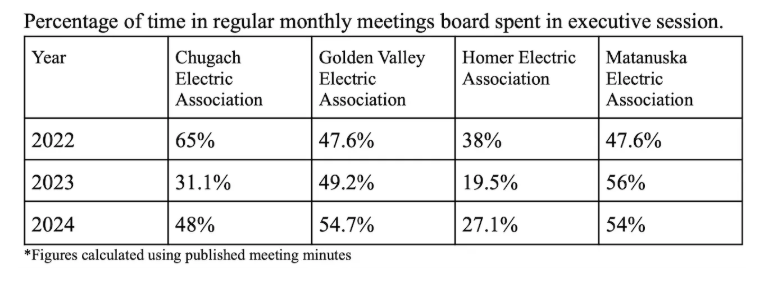ENERGY UPDATES FOR MAY 2025
Welcome to the MAY Energy Newsletter!
This newsletter is your place to get all that good juicy Alaskan energy gossip! Launched in 2023, we've taken a long pause over the last year, but now, we're back, with a revamped and reinforced volunteer writing crew, from both Keep it in the Ground and Renewable Energy working groups. If you’d like to receive these updates via email, click the link below!
Read on to learn about whats up with Alaska’s AKLNG pipe dream, the status Senate Bill 92 (Closing the S-Corp Loop Hole), and dive into the transparency problems facing Golden Valley Electric Association…
AKLNG, a proposed 800 mile natural gas pipeline from the North Slope to Nikiski, has existed in several fantasy forms over the past four decades, and is currently being spun by state huckster AGDC and Outside project manager Glenfarne as a multiphase project that will first solve Southcentral Alaska’s energy shortage, and then provide a sustaining revenue for the State. There are still several concerns up in the air, such as a spur line to Fairbanks. AGDC has been busy at the legislature, presenting to Senate Resources, Senate Finance, House Resources, and House Budget & Audit.
As of April 23 (announced in both House Resources and Senate Legislative Budget and Audit Committee) there is a quasi update in that Glenfarne has decided not to move forward with the $50 million from AIDEA. It is unclear yet on whether or not there is still an appropriations line item in the legislative budget for AGDC.
SB 92 update: Senate Bill 92, which proposes an update to State tax policy for S-Corps in the oil and gas industry that make more than $5 million a year. This update has been recommended by the Department of Revenue since 2014, is supported by a majority of Alaskans, and could return significant revenue back to the Alaskan people. SB 92 was first heard in Senate Resources, but has now moved to Senate Finance. This is a great opportunity to provide public comment to our elected representatives!
GVEA Update: Golden Valley Electric Association elections are about to start–ballots will be mailed and online voting will open on May 9. In light of this, the Energy newsletter team would like to draw attention to a few issues and possible irregularities surrounding GVEA’s candidate selection. GVEA’s district nominating committees, which operate with minimal transparency, have an inordinate amount of influence on who appears on the ballot. And a recent change to GVEA’s bylaws may have inadvertently made them more powerful. This year only one candidate was put forth from both districts despite multiple applicants. Check out our blog to learn more.
Did you know? Did you know that the GVEA board spends more than half of their time in Executive Session, more than any other co-op in Alaska? Meeting minutes (which are public) recorded during the Executive Session are limited and often extremely vague. Let your board member know that you’d like to see more transparency from them! Contact GVEA's Directors
Image caption: From AETP Newsletter #4 (May 5, 2025)
On-bill financing at GVEA: We’ve got exciting news! GVEA’s on-bill financing pilot program is live! Called Responsible Energy Decisions Using Cost-effective Efficiencies or REDUCE, this program aims to help reduce member/owners’ energy bills by improving energy efficiency and installing renewable energy via low interest loans. Unfortunately, in its current form, this pilot program will only help middle and upper class homeowners, leaving renters and people at or near the poverty line (i.e., the people most in need of this kind of assistance) in the lurch. But, this is a great first step that will hopefully grow to include everyone once a full on-bill financing program is adopted.
Want to learn more?
To apply to the On-Bill Financing Pilot Program, visit this link from GVEA!
Since the energy world is made up of a soup of acronyms, we plan to offer an alphabet explainer in each issue in order to demystify the language of Alaskan energy! This first one starts with some of the basics, and explains the main acronyms we use in this issue.
AGDC: Alaska Gasline Development Corporation — AGDC is an independent, public corporation owned by the State of Alaska created by the Legislature in 2013. They are currently the lead party developing the "AK LNG project" and this is their only goal. Synthesized from the March 22, AGDC AK LNG Project Update. At the time of writing the AGDC website was down.
AIDEA: Alaska Industrial Development and Export Authority — AIDEA is a public corporation of the State of Alaska, constituting a political subdivision under the state's laws. It was created by the Alaska Legislature to "promote, develop and advance the general prosperity and economic welfare of the people of Alaska, to relieve problems of unemployment, and to create additional employment." From AIDEA.
S-Corp: Small Business Corporation — S corporations are corporations that elect to pass corporate income, losses, deductions, and credits through to their shareholders for federal tax purposes. Shareholders of S corporations report the flow-through of income and losses on their personal tax returns and are assessed tax at their individual income tax rates. This allows S corporations to avoid double taxation on the corporate income. S corporations are responsible for tax on certain built-in gains and passive income at the entity level. From the Internal Revenue Service.
LNG: Liquified Natural Gas — LNG is natural gas that has been cooled to a liquid state (liquefied), to about -260° Fahrenheit, for shipping and storage. The volume of natural gas in a liquid state is about 600 times smaller than its volume in a gaseous state (in natural gas pipelines). The liquefaction process, developed in the 19th century, makes it possible to transport natural gas to places natural gas pipelines do not reach and to use natural gas as a transportation fuel. From the US Energy Information Administration.
When it’s frigid out, Toł loves getting bundled up in his dog clothes so he can play games in the snow. This pup says, “Awoo! Keep Fairbanks cold!”
Inspired by “Catch Of The Day” in the HEATED newsletter.
Become a Member of FCAC! By signing up for membership, you become part of the climate justice movement in creating a sustainable and equitable future for Alaska. As a member, you can join others and contribute to our Coalition projects and campaigns while getting exclusive resources and engaging in opportunities for climate action, community gatherings, organizing training, and leadership development.
FCAC is hiring! We are looking to fill three positions on our staff at FCAC! And if you made it to the end of this email, you might really be interested in our Energy Democracy Organizer position! Stop by our job page at fbxclimateaction.org/jobs to read the position profiles!










